Lucas Smaira
DeepMind
Perception Test: A Diagnostic Benchmark for Multimodal Video Models
May 23, 2023


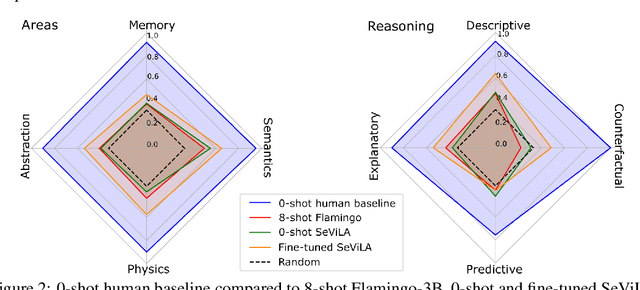
Abstract:We propose a novel multimodal video benchmark - the Perception Test - to evaluate the perception and reasoning skills of pre-trained multimodal models (e.g. Flamingo, BEiT-3, or GPT-4). Compared to existing benchmarks that focus on computational tasks (e.g. classification, detection or tracking), the Perception Test focuses on skills (Memory, Abstraction, Physics, Semantics) and types of reasoning (descriptive, explanatory, predictive, counterfactual) across video, audio, and text modalities, to provide a comprehensive and efficient evaluation tool. The benchmark probes pre-trained models for their transfer capabilities, in a zero-shot / few-shot or limited finetuning regime. For these purposes, the Perception Test introduces 11.6k real-world videos, 23s average length, designed to show perceptually interesting situations, filmed by around 100 participants worldwide. The videos are densely annotated with six types of labels (multiple-choice and grounded video question-answers, object and point tracks, temporal action and sound segments), enabling both language and non-language evaluations. The fine-tuning and validation splits of the benchmark are publicly available (CC-BY license), in addition to a challenge server with a held-out test split. Human baseline results compared to state-of-the-art video QA models show a significant gap in performance (91.4% vs 43.6%), suggesting that there is significant room for improvement in multimodal video understanding. Dataset, baselines code, and challenge server are available at https://github.com/deepmind/perception_test
Zorro: the masked multimodal transformer
Jan 23, 2023



Abstract:Attention-based models are appealing for multimodal processing because inputs from multiple modalities can be concatenated and fed to a single backbone network - thus requiring very little fusion engineering. The resulting representations are however fully entangled throughout the network, which may not always be desirable: in learning, contrastive audio-visual self-supervised learning requires independent audio and visual features to operate, otherwise learning collapses; in inference, evaluation of audio-visual models should be possible on benchmarks having just audio or just video. In this paper, we introduce Zorro, a technique that uses masks to control how inputs from each modality are routed inside Transformers, keeping some parts of the representation modality-pure. We apply this technique to three popular transformer-based architectures (ViT, Swin and HiP) and show that with contrastive pre-training Zorro achieves state-of-the-art results on most relevant benchmarks for multimodal tasks (AudioSet and VGGSound). Furthermore, the resulting models are able to perform unimodal inference on both video and audio benchmarks such as Kinetics-400 or ESC-50.
TAP-Vid: A Benchmark for Tracking Any Point in a Video
Nov 07, 2022Abstract:Generic motion understanding from video involves not only tracking objects, but also perceiving how their surfaces deform and move. This information is useful to make inferences about 3D shape, physical properties and object interactions. While the problem of tracking arbitrary physical points on surfaces over longer video clips has received some attention, no dataset or benchmark for evaluation existed, until now. In this paper, we first formalize the problem, naming it tracking any point (TAP). We introduce a companion benchmark, TAP-Vid, which is composed of both real-world videos with accurate human annotations of point tracks, and synthetic videos with perfect ground-truth point tracks. Central to the construction of our benchmark is a novel semi-automatic crowdsourced pipeline which uses optical flow estimates to compensate for easier, short-term motion like camera shake, allowing annotators to focus on harder sections of video. We validate our pipeline on synthetic data and propose a simple end-to-end point tracking model TAP-Net, showing that it outperforms all prior methods on our benchmark when trained on synthetic data.
Towards Learning Universal Audio Representations
Dec 01, 2021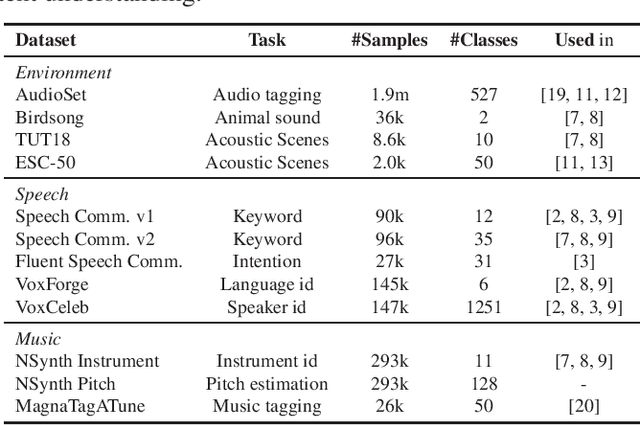
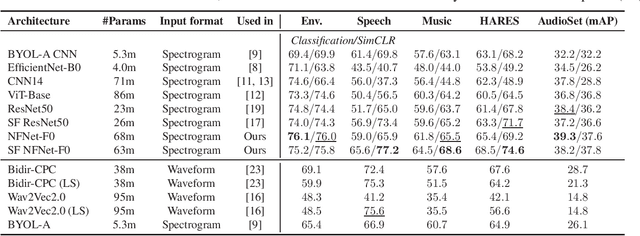

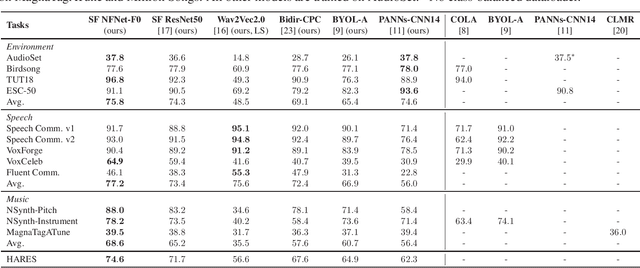
Abstract:The ability to learn universal audio representations that can solve diverse speech, music, and environment tasks can spur many applications that require general sound content understanding. In this work, we introduce a holistic audio representation evaluation suite (HARES) spanning 12 downstream tasks across audio domains and provide a thorough empirical study of recent sound representation learning systems on that benchmark. We discover that previous sound event classification or speech models do not generalize outside of their domains. We observe that more robust audio representations can be learned with the SimCLR objective; however, the model's transferability depends heavily on the model architecture. We find the Slowfast architecture is good at learning rich representations required by different domains, but its performance is affected by the normalization scheme. Based on these findings, we propose a novel normalizer-free Slowfast NFNet and achieve state-of-the-art performance across all domains.
Human-Agent Cooperation in Bridge Bidding
Nov 28, 2020
Abstract:We introduce a human-compatible reinforcement-learning approach to a cooperative game, making use of a third-party hand-coded human-compatible bot to generate initial training data and to perform initial evaluation. Our learning approach consists of imitation learning, search, and policy iteration. Our trained agents achieve a new state-of-the-art for bridge bidding in three settings: an agent playing in partnership with a copy of itself; an agent partnering a pre-existing bot; and an agent partnering a human player.
A Short Note on the Kinetics-700-2020 Human Action Dataset
Oct 21, 2020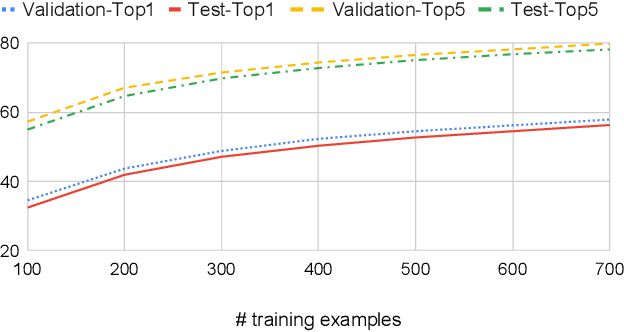
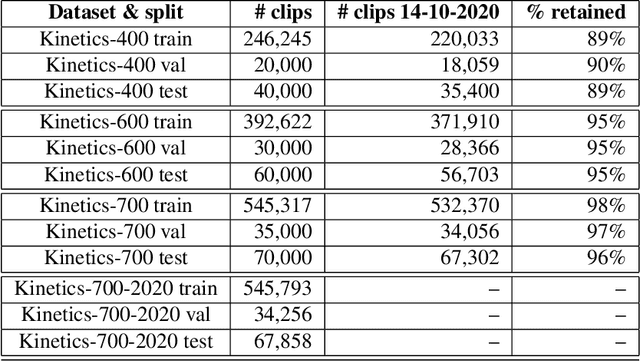


Abstract:We describe the 2020 edition of the DeepMind Kinetics human action dataset, which replenishes and extends the Kinetics-700 dataset. In this new version, there are at least 700 video clips from different YouTube videos for each of the 700 classes. This paper details the changes introduced for this new release of the dataset and includes a comprehensive set of statistics as well as baseline results using the I3D network.
Self-Supervised MultiModal Versatile Networks
Jun 29, 2020
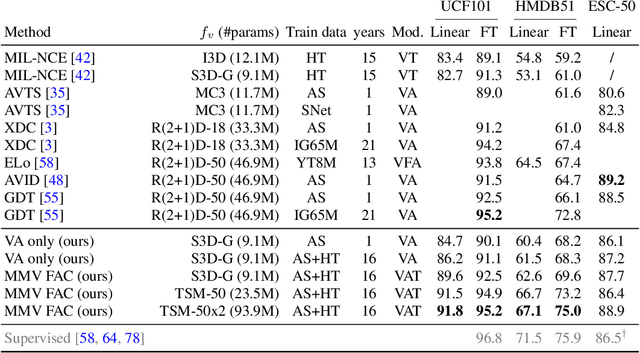
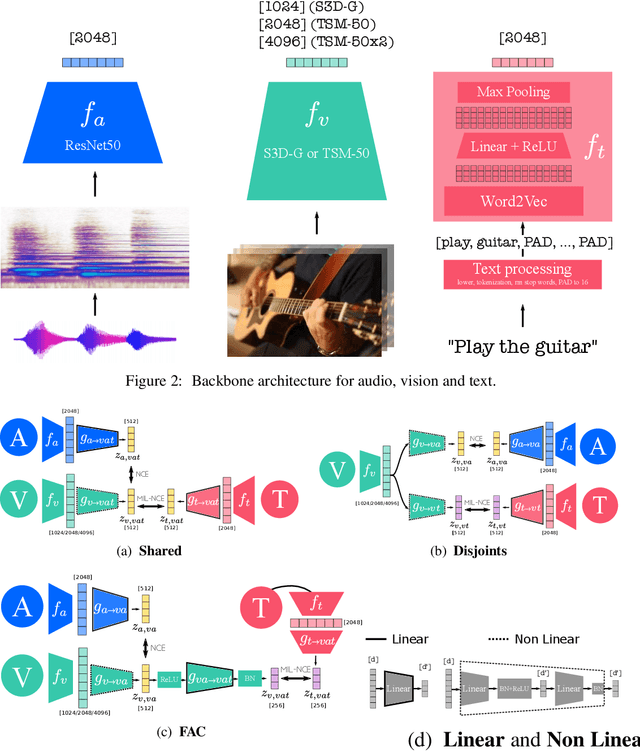
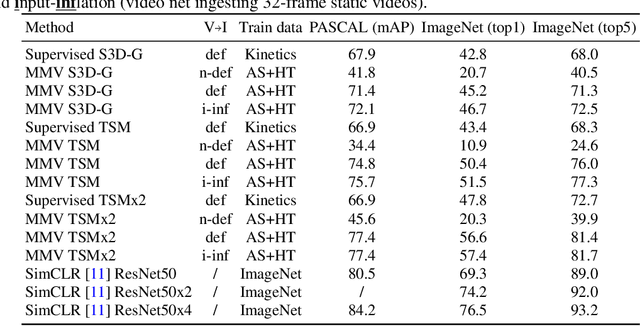
Abstract:Videos are a rich source of multi-modal supervision. In this work, we learn representations using self-supervision by leveraging three modalities naturally present in videos: vision, audio and language. To this end, we introduce the notion of a multimodal versatile network -- a network that can ingest multiple modalities and whose representations enable downstream tasks in multiple modalities. In particular, we explore how best to combine the modalities, such that fine-grained representations of audio and vision can be maintained, whilst also integrating text into a common embedding. Driven by versatility, we also introduce a novel process of deflation, so that the networks can be effortlessly applied to the visual data in the form of video or a static image. We demonstrate how such networks trained on large collections of unlabelled video data can be applied on video, video-text, image and audio tasks. Equipped with these representations, we obtain state-of-the-art performance on multiple challenging benchmarks including UCF101, HMDB51 and ESC-50 when compared to previous self-supervised work.
Visual Grounding in Video for Unsupervised Word Translation
Mar 26, 2020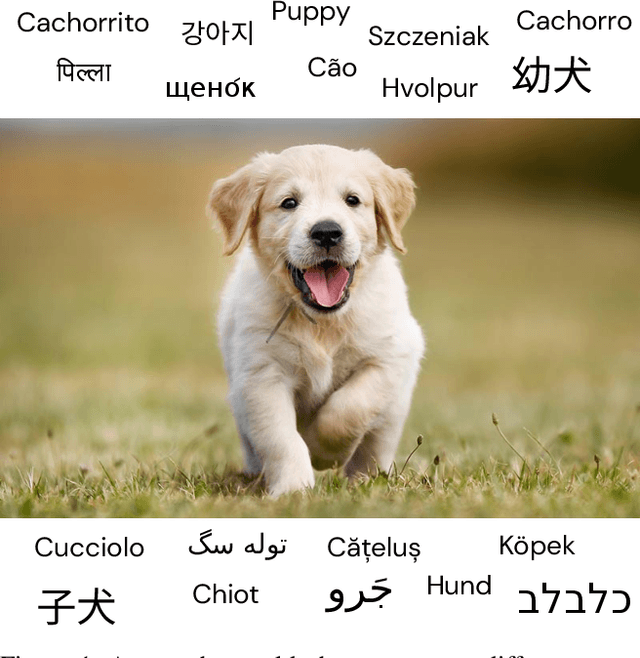
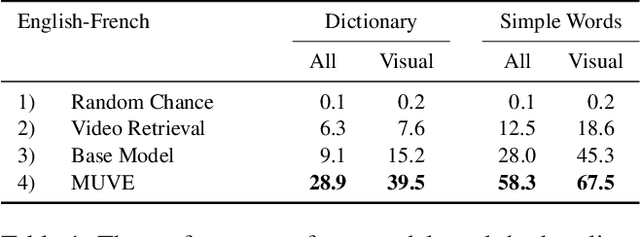

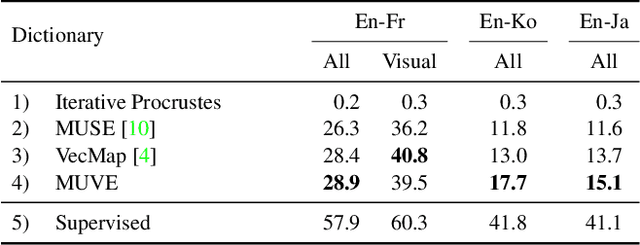
Abstract:There are thousands of actively spoken languages on Earth, but a single visual world. Grounding in this visual world has the potential to bridge the gap between all these languages. Our goal is to use visual grounding to improve unsupervised word mapping between languages. The key idea is to establish a common visual representation between two languages by learning embeddings from unpaired instructional videos narrated in the native language. Given this shared embedding we demonstrate that (i) we can map words between the languages, particularly the 'visual' words; (ii) that the shared embedding provides a good initialization for existing unsupervised text-based word translation techniques, forming the basis for our proposed hybrid visual-text mapping algorithm, MUVE; and (iii) our approach achieves superior performance by addressing the shortcomings of text-based methods -- it is more robust, handles datasets with less commonality, and is applicable to low-resource languages. We apply these methods to translate words from English to French, Korean, and Japanese -- all without any parallel corpora and simply by watching many videos of people speaking while doing things.
* CVPR 2020
End-to-End Learning of Visual Representations from Uncurated Instructional Videos
Jan 17, 2020


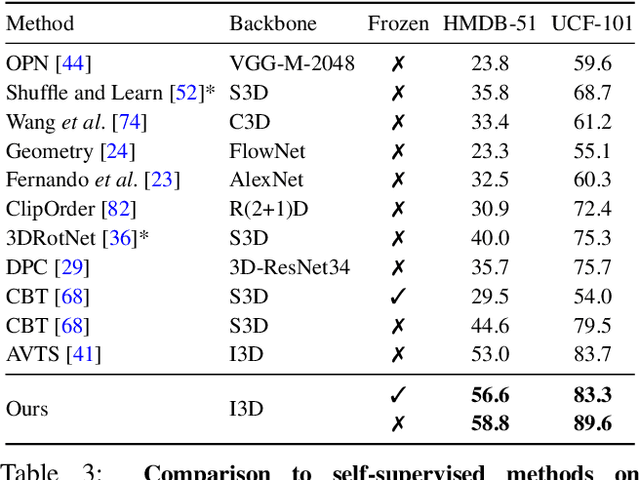
Abstract:Annotating videos is cumbersome, expensive and not scalable. Yet, many strong video models still rely on manually annotated data. With the recent introduction of the HowTo100M dataset, narrated videos now offer the possibility of learning video representations without manual supervision. In this work we propose a new learning approach, MIL-NCE, capable of addressing misalignments inherent to narrated videos. With this approach we are able to learn strong video representations from scratch, without the need for any manual annotation. We evaluate our representations on a wide range of four downstream tasks over eight datasets: action recognition (HMDB-51, UCF-101, Kinetics-700), text-to-video retrieval (YouCook2, MSR-VTT), action localization (YouTube-8M Segments, CrossTask) and action segmentation (COIN). Our method outperforms all published self-supervised approaches for these tasks as well as several fully supervised baselines.
 Add to Chrome
Add to Chrome Add to Firefox
Add to Firefox Add to Edge
Add to Edge